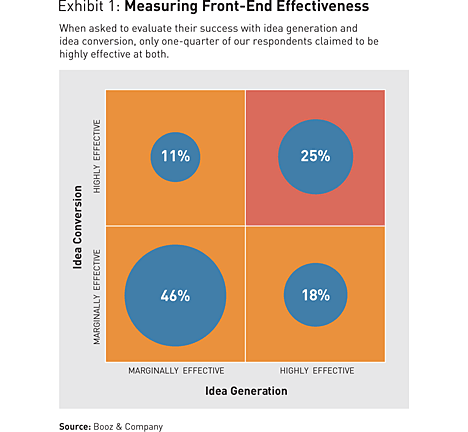Excellent data on the state of global innovation: idea generation, idea conversion, and crowdsourcing
Strategy + Business magazine has just launched its annual Global Innovation 1000 study, a deep analysis of the 1000 biggest spenders on innovation globally. As it happens I separately caught up with S+B editor Art Kleiner and Booz & Co Chief Marketing Officer Tom Stewart last Friday in New York (more on those conversations later), fortunately getting out before Sandy hit town.
Here is a good video of the highlights of the study:
The theme of the study this year was on the early stages of innovation, in generating ideas and then converting them to products and services.
This is of particularly strong interest to in my own focus on distributed innovation and the role of crowdsourcing in driving value creation.
One of the useful distinctions in the report is between idea generation and idea conversion. More organizations considered themselves effective at idea generation than idea conversion, with only a quarter ranking themselves highly effective at both.

Most executives think about crowdsourcing and distributed innovation as tools for idea generation. They can be very powerful in this domain, particularly in being able to bring in more diverse perspectives and insights from different fields.
However crowdsourcing also has a strong role to play in the idea conversion process. Innocentive, which I first wrote about in my 2002 book Living Networks, is in fact primarily used within the product development process, in isolating elements from a broader development program that may be better done by crowds rather than internally. This is often a case of “not reinventing the wheel”, by looking to the world for an existing solution.
This requires modularization of the innovation process. It is absolutely true that the you cannot take the ‘idea conversion’ process as a whole outside the organization. Ideas have to be converted to be ready for the market in a way that is unique to the company and its positioning.
However breaking down that process into modular elements (as I describe in the chapter on Distributed Innovation in Getting Results From Crowds) can make it far more efficient in many ways, not least by being able to select the most effective innovation process for each element, including potentially going to external talent.
Crowdsourcing was in fact not a major theme of the report, and anecdotally relatively few companies surveyed considered it to be a significant element of their innovation processes.
On the one hand, there is unquestionably a long way to go until distributed innovation becomes a core discipline for many organizations. The analysis of innovation styles in the Global Innovation 1000 study suggests that a significant proportion of organizations will never get there. However over time I believe that higher performance in innovation will be significantly correlated to the degree of external focus in the innovation process.
In addition, a significant proportion of organizations look primarily to their customers for needs and insights into innovation potential. The more successful of these companies actively engage their customers in the innovation process, rather than simply uncovering needs. Engaging customers in a co-creation process will undoubtedly be a key driver of innovation success moving forward.
In an increasingly rapidly-changing world, innovation will be central to organizations’ success. There are choices to be made in how to do that most effectively. While there is a lot further to go, I believe we will see those that embrace external talent and ideas have a real lead on those that keep innovation internal.
